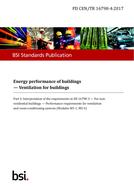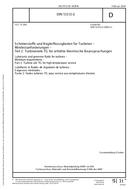BS PD CEN/TR 16798-4 PDF
$209.00
Energy performance of buildings. Ventilation for buildings. Interpretation of the requirements in EN 16798-3. For non-residential buildings. Performance requirements for ventilation and room-conditioning systems(Modules M5-1, M5-4)
| Published by | Publication Date | Number of Pages |
| BSI | 07/11/2017 | 74 |
Description
BS PD CEN/TR 16798-4 – Energy performance of buildings. Ventilation for buildings. Interpretation of the requirements in EN 16798-3. For non-residential buildings. Performance requirements for ventilation and room-conditioning systems(Modules M5-1, M5-4)
BS PD CEN/TR 16798-4:2017 refers to EN 16798-3.
It contains information to support the correct understanding and use of EN 16798-3.
This Technical Report does not contain any normative provision.
This Technical Report applies to the design and implementation of ventilation, air conditioning androom conditioning systems for non-residential buildings subject to human occupancy, excludingapplications like industrial processes. It focuses on the definitions of the various parameters, which arerelevant for such systems.
The guidance for design given in this standard and its annexes are mainly applicable to mechanicalsupply and exhaust ventilation systems, and the mechanical part of hybrid ventilation systems.
Furthermore general design principles of natural ventilation systems are introduced in Annex D.
Applications for residential ventilation are not dealt with in this technical report. Performance ofventilation systems in residential buildings are dealt with in CEN/TR 14788.
The classification uses different categories. For some values, examples are given and, for requirements,typical ranges with default values are presented. The default values given in this standard are notnormative as such, and should be used where no other values are specified. Classification should alwaysbe appropriate to the type of building and its intended use, and the basis of the classification should beexplained if the examples given in the standard are not to be used.
NOTE Different standards might express the categories for the same parameters in a different way, and thecategory symbols may be different.
Cross References:
EN 16798-3:2017
CENISO/TR 52000-2
EN 308:1997
ISO/TR 52000-2:2017
EN 15287-1:2007
EN 1886:2007
EN 15287-2:2008
EN 13053:2006
prEN 16798-1 EN 15459:2007
ISO 16814:2008 Ed 1
EN 16798-5-1:2017
EN 16798-17:2017
EN 12599:2012
EN 15780:2011
ISO 13791:2012
ISO 16890-1:2016
EN 15193:2007
EN 12464-1:2011
ISO 9972:2015
ISO 7726:1998
CEN/TS 16628:2014
EN ISO 7726 (ISO 7726:1998 AS)
CEN/TS 16629:2014
CEN/TR 14788:2006
EN 15232:2012
EN 13030:2001
EN 15727:2010
EN 13180:2001
EN 16798-5-2:2017
EN 12237:2003
EN 1505:1997
99/30/EC
FprEN ISO 52000-1
EN ISO 16890
EN 15240:2007
EN 16798-7:2017
CEN CR 1752:1998
EN 15239:2007
EN 15243:2007
EN ISO 13791 (ISO 13791:2012) AS
EN 1506:2007
EN 1507:2006
EN 1751:2014
EN 12097:2006
EN 13141-5:2004
EN ISO 9972 (ISO 9972:2015) AS
CEN/TR 16798-18:2017
All current amendments available at time of purchase are included with the purchase of this document.
Product Details
- Published:
- 07/11/2017
- ISBN(s):
- 9780580858710
- Number of Pages:
- 74
- File Size:
- 1 file , 2.9 MB
- Product Code(s):
- 30297482, 30297482, 30297482
- Note:
- This product is unavailable in Ukraine, Russia, Belarus




